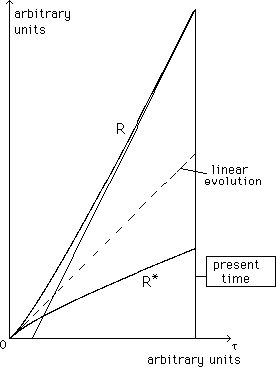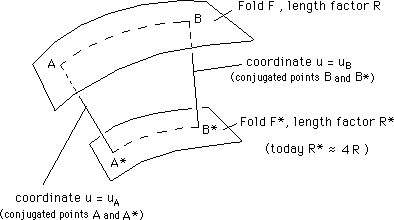(33- b)
(33- c)
(33- d)
...From
(33-b) and (33-d) the curvature indixes k and k* must be negative, then we
get, with k = k* = - 1 . The initial evolution laws are simply linear:
R = R* »
r. But,
as will be shown later the metter densities may become different. Then we
get the system :
(34-a)
(34-b)
(34-c)
(34-d)
from which we get immediatly :
(35-a)
(35-b)
Introducing the mass-conservation in both folds :
(36)
Then the system becomes
:
(37-a)
(37-b)
...Notice that R = R* gives R" = R*" = 0. On another hand, if the two universes were "fully coupled", i.e. R*/R = constant, then they would correspond to Friedmann models, with "parallel evolutions". But we consider that they are coupled by gravitational field, through (37-a) and (37-b) that show that the linear expansion is unstable. If, for an example, if R > R* then R" > 0 and R*" < 0 . The system can be numerically solved. The typical solution corresponds to figure 1.

There is a "common history", described though the common sytem of coordinates :
...Using
(13) to (16) we may return to the systems { t ,
r , q , j
} and
{ t* , r* , q
, j }.
Notice that the velocities of the light velocities c and c* and the characteristic
time T and
T * may
be different.
If c = c*
and T
= T* = 1
we get simply (t = t
; t* = - t)
Why canít we take simply
r* = r * ?
Because lenghts scales
R and R* are found to
be different. Consider two sets of conjugated points (a , A*) and
(B , B*). Assume (qA
= qB ; jA
= jB).
The two sets correspond to radial marker uA
and uB. As they
are conjugated, A
and A* refer to
the same radial marker uA . Same
thing for conjugated points B and
B*, corresponding
to uB value. The
distance AB is
R (uB -
uA) , while
the distance A*B* is R* (uB
- uA). They
are different, for R* ¹
R .

... If one assumes that the coordinates (t , x , y , z) and (t* , x* , y* , z*) refers to two observers, located in folds F and F*, they are like two men observing the same movie, in two distinct rooms but :
-
- the screens have different
sizes (R and R*).
- the orders of the events are opposite (t and t* have opposite signs)
- what is "right" on
one screen is "left" on the other one
(enantiomorphy)
